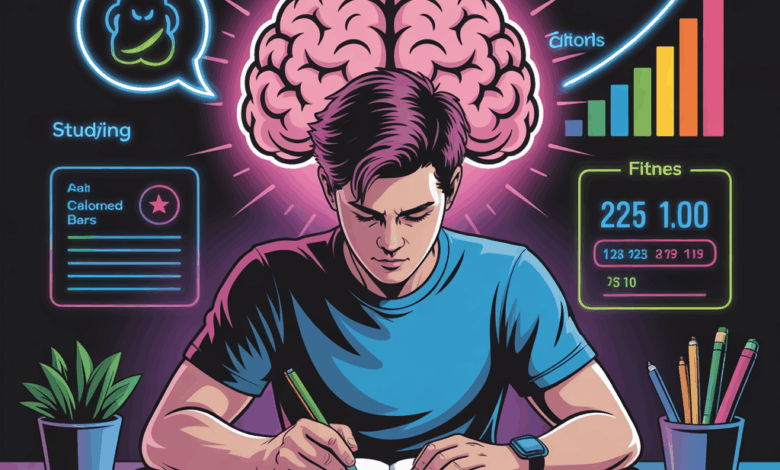How Many Calories Does Studying Burn

Ever sat through a four-hour study binge and wondered, “Did all that brainpower torch any calories?” If you’re tracking weight or just curious about peak productivity, the question — how many calories does studying burn — is both practical and oddly satisfying to answer. Let’s dig into the facts, bust some myths, and give you realistic tips to turn study time into a more active, healthier habit.
How many calories does studying burn? — The short, science-backed answer
Studying is mentally demanding, but in terms of whole-body calorie burn it behaves much like other sedentary activities. Most desk-based studying burns roughly the same number of calories as sitting quietly: about 60–120 kcal per hour for an average adult. The exact amount depends on body weight, metabolism, posture, and small movements (fidgeting), but thinking hard doesn’t dramatically increase total calories burned.
Why the number is relatively low
Your brain does use a lot of energy — roughly 20% of resting metabolic energy — but that energy is mostly consumed at rest. Intense concentration increases brain glucose use a little, yet the rest of your body doesn’t suddenly start burning a lot more. In plain terms: brain activity is energy-hungry, but it’s not a high-calorie-burning activity the way running or circuit training is.
Estimated calorie ranges by body weight (approximate)
- 50 kg (110 lb): ~50–90 kcal per hour
- 70 kg (154 lb): ~65–115 kcal per hour
- 90 kg (198 lb): ~85–140 kcal per hour
These rough estimates use standard MET values for light-intensity desk work (about 1.3–1.8 MET). For a more precise estimate you can use the MET formula: kcal/min = (MET × 3.5 × weight(kg)) / 200.
Why studying doesn’t burn many calories (and what really matters)
It helps to separate brain metabolism from whole-body calorie expenditure. The brain’s baseline energy needs are high but stable. Short bursts of intense thinking increase glucose consumption in specific brain regions, but not enough to make a big dent in your daily calorie balance. What really moves the needle is physical movement — even small changes in posture, walking breaks, or fidgeting (NEAT: non-exercise activity thermogenesis) can add up over the day.
How to boost calorie burn during study sessions (smart, realistic strategies)
If your goal is to burn more calories while maintaining focus, combine study time with low-impact activity and structure your sessions to include movement. These tactics preserve concentration while increasing energy use and improving mood.
Active study tips
- Stand up or use a standing desk for part of the session to increase metabolic rate slightly and reduce sedentary time.
- Try walking while listening to recorded lectures or summaries (audio study). A slow walk on a treadmill desk or a walk outside boosts calories and creativity.
- Use the Pomodoro method: study 25 minutes, move for 5 minutes. Do a few bodyweight moves during breaks to spike heart rate and rehearse posture.
- Fidget intentionally: small movements like foot taps, standing leg shifts, or using a balance cushion increase NEAT.
Quick workout variations to pair with study sprints
Incorporate short, efficient exercises between study blocks to elevate calorie burn without wrecking focus:
- 2–4 minute bodyweight circuit: 30s chair squats, 30s push-ups (knees ok), 30s mountain climbers, 30s plank.
- 7-minute HIIT: alternating 20s high effort / 10s rest for 7 exercises (jumping jacks, burpees, lunges, etc.).
- Desk-friendly moves: standing calf raises, seated leg extensions, desk push-ups, resistance band rows.
For more structured options, check out our workout routines tailored for busy students and professionals.
Study-friendly nutrition and lifestyle tweaks
Fueling your brain and body supports both focus and moderate calorie burn. The right foods help sustain concentration and prevent energy crashes that lead to sedentary snacking.
- Choose slow-release carbs (oats, whole grain toast) and pair with protein (eggs, Greek yogurt) for steady attention.
- Include brain-healthy fats: nuts, seeds, and fatty fish are great for cognitive function.
- Stay hydrated. Even mild dehydration reduces cognitive performance and can increase perceived effort.
- Limit sugary snacks that create energy spikes and crashes — aim for balanced snacks (apple + peanut butter, hummus + veg). See our nutrition guides for study-day meal ideas.
Real-world examples: turning study time into active time
Scenario 1 — College student cramming: Alternates 30 minutes of focused review with 5 minutes of bodyweight moves at the desk. Over a 4-hour session this adds 20–40 minutes of moderate movement and an extra 100–250 kcal burned compared to sitting still.
Scenario 2 — Office professional learning a new skill: Uses standing meetings for 1-hour training blocks and takes a 10-minute brisk walk after each session. The increased NEAT plus walking can add 150–300 kcal over a workday.
Small changes stack. Making study time slightly more active consistently leads to better posture, fewer aches, improved mood, and modestly higher daily calorie expenditure.
Frequently Asked Questions
Studying itself doesn’t target fat loss. Fat loss requires a calorie deficit over time. However, increasing movement during study sessions (walking breaks, standing, micro-workouts) helps create that deficit and supports body composition goals.
At an average rate of 70–100 kcal per hour, 8 hours of studying would burn about 560–800 kcal. Remember that’s similar to sitting at work; adding movement breaks will increase that total.
Yes. NEAT (non-exercise activity thermogenesis) — everyday movements like fidgeting, standing, and walking — can add hundreds of calories to your daily burn over time. Focus on sustainable habits rather than forcing constant movement.
Conclusion — Put the answer into action
So, how many calories does studying burn? Not as many as a workout — usually about 60–120 kcal per hour — but by mixing in standing, walking, and short workouts you can boost energy use, sharpen focus, and feel better during long study sessions. Try a simple plan today: study for 25–45 minutes, then move for 5–10 minutes. Track how you feel and tweak the routine. For ready-to-go plans and food ideas, explore our wellness tips, workout routines, and nutrition guides.
Ready to level up your study routine? Pick one movement habit from this article and commit to it for a week — your energy, posture, and perhaps your grades will thank you. Share your progress or ask for a personalized micro-workout plan in the comments!





